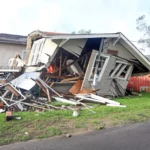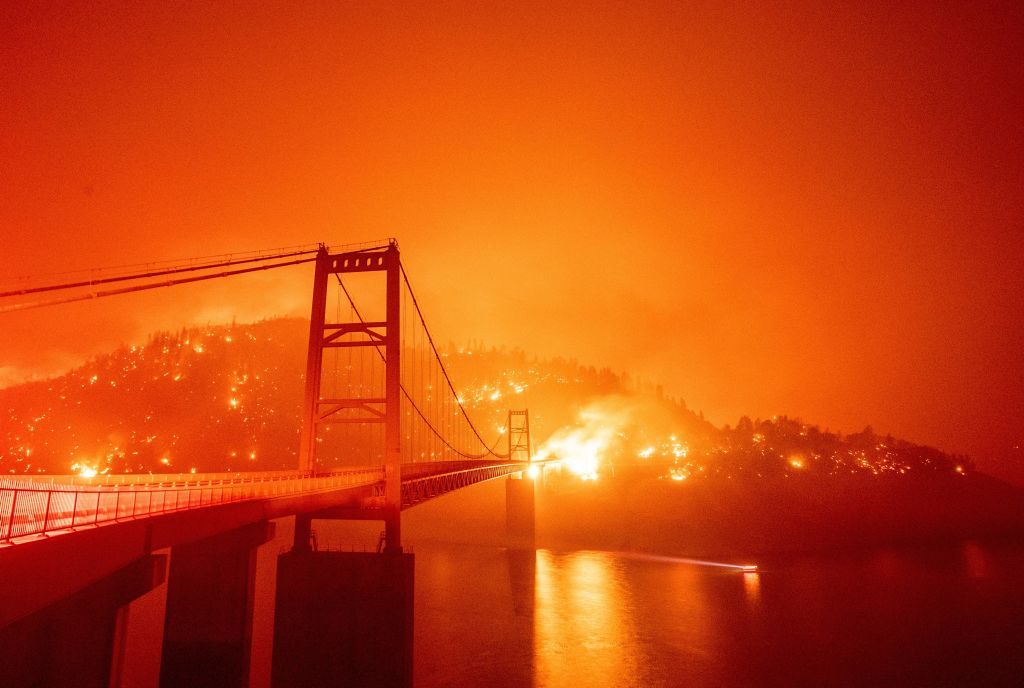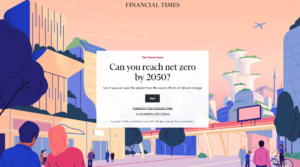There may still be climate change deniers but the U.S. Army is not one of them. If they have a plan, should each and everyone of us have a plan?
Climate & Disaster- Preparing for the Worst
 Preparing for climate change often focuses on the steps you can do to mitigate your environmental impact or on what systemic steps will be required to make a meaningful transition away from fossil fuels towards a cleaner energy future. These are important issues, but there is another aspect of climate change that often goes unaddressed that I want to discuss with you all today. How should we prepare for climate disasters?
Preparing for climate change often focuses on the steps you can do to mitigate your environmental impact or on what systemic steps will be required to make a meaningful transition away from fossil fuels towards a cleaner energy future. These are important issues, but there is another aspect of climate change that often goes unaddressed that I want to discuss with you all today. How should we prepare for climate disasters?
Natural disasters aren’t anything new. Tornadoes, floods, wildfires, hurricanes, and so many other hazards are an unfortunate part of life. However, climate change is projected to increase both the frequency and intensity of such hazards. This means you might be faced with an unexpected flood or storms far stronger than you have experienced in the past. With this in mind, it is important to take steps to make sure you are safe should one of these hazards strike in your community.
 The most important step you can take is to familiarize yourself with what dangerous weather hazards are common in your community. The National Weather Service has many resources that can help one learn about what types of storms or other dangers are common to an area. More importantly, these resources also provide information about how to prepare for such events, what the warning signs might be, and how to protect yourself during and after such an event. I would highly recommend checking out Weather Ready Nation to get more information like this[1].
The most important step you can take is to familiarize yourself with what dangerous weather hazards are common in your community. The National Weather Service has many resources that can help one learn about what types of storms or other dangers are common to an area. More importantly, these resources also provide information about how to prepare for such events, what the warning signs might be, and how to protect yourself during and after such an event. I would highly recommend checking out Weather Ready Nation to get more information like this[1].
In a more immediate sense, it’s also wise to consider what supplies and tools you can have on hand in order to prepare for severe weather. A basic weather radio is a commonly suggested tool for those living in Tornado Alley. It’s also wise to keep a basic cache of essential supplies for times of extreme weather. Bandages, a small store of clean water (jugs are a common choice), some non perishable food, weather proof matches, etc. You never know when you might be out of power or in a bind for a few days, so keeping these basics can really help make a difference.
Lastly, its wise to consider more specialized materials based on the weather hazards you might face. For example, with climate change making hurricanes more severe and frequent, it may be wise to familiarize yourself and your family with hurricane evacuation routes. For those in places prone to tornadoes, practice safety drills may be a good step. Those vulnerable to fire may want to be familiar with their evacuation routes, as with hurricanes, or work on developing a go-back, just in case. Of course, investing in portable solar rechargers for electronics so you can continue to access information is never a bad choice either.
In summary, climate change may make natural hazards more dangerous, but you can still take steps to be prepared. These steps don’t have to come at the cost of personal steps to reduce and recycle either. So keeping these tips in mind can help you both protect the environment, and yourself.
[1] https://www.weather.gov/wrn/
Can YOU reach net zero by 2050? (A Simulation)
3 Quick Tips for Protecting the Environment and Your Wallet

Climate Change and pollution often dominate the conversation around the environment and can appear to be large and intimidating problems. This doesn’t mean one is powerless to make a difference. We would like to share 3 tips we have found to be exceptionally helpful for protecting our environment while also helping to pad your pocket book. These tips may seem obvious to some, but a surprising number of people overlook these simple ideas to help make a personal difference with environmental and financial benefits!
- Consider a thermos instead of using bottled water: Bottled water has become a popular go to solution for staying hydrated on the go. But unfortunately this convenience comes at the cost of an extensive contribution to plastic pollution and worse, often uses water sourced from places that are significantly water insecure. Instead, consider investing in a simple thermos and using it while on the go. The costs of water from the tap are far below the distorted costs of bottled water and will quickly make up for the cost of a few thermoses.
Some quick math show’s how quickly this environmentally friendly shift can benefit you. A basic thermos can cost anywhere from $15 to $30. In contrast, a 24 pack of bottled water will cost you a little over $5 (though many places may cost more). If you consume a single bottle a day, you will spend on average about $6.25 a month. At this rate, a thermos would begin to save you over the long term in as little as 2 and a half months, last far longer, and not contribute to the problem of plastic pollution. And with a recent report finding less than 6% of plastic is recycled in the US[1], this can be a good first step for addressing plastic pollution in your community.
2)A home rotary fan: It gets hot in the summer and turning up the a/c is perhaps the most soothing way to deal with this problem. Unfortunately air-conditioning can be a very expensive service, and lead to significant spikes in your power bill. Worse still, the energy consumption of cities worth of such devices can strain local power grids, leading to brown outs or leading to significantly increased emissions from unclean fossil fuel based power plants. A simple rotary fan can sometimes be sufficient for helping to reduce ones energy consumption without forgoing the ability to cool off during the hot summer months.
3) A home garden: While a fun hobby for some, growing your own food can be both a fun way to help the environment while also protecting your wallet from the challenges of inflation. From backyards full of rows upon rows of vegetables, to the simple 2 pots of tomatoes on the back porch; growing food in a local garden can help you save money while mitigating the environmental impacts of relying upon food transported hundreds (or even thousands) of miles from farm to plate.
[1] https://www.beyondplastics.org/press-releases/the-real-truth-about-plastics-recycling
Climate Migration

Climate change has increased the frequency and intensity of droughts, hurricanes, tornadoes and other severe climate events. We often think of migrants as people from other countries, often wanting to come the the United States. But what may surprise you is that some people inside the United States are becoming climate migrants. Check out the CNN article below for more information on what some people are experiencing.
https://www.cnn.com/2021/04/12/opinions/climate-migration-in-america-california-duluth-sutter/index.html
SEC and Climate Change
Summary: The SEC proposed new Rules requiring companies to share “climate change” impact issues that could effect the performance of the underlying stock prices. Read the announcement below.
+++++++++++++++++++++++++
SEC Proposes Rules to Enhance and Standardize Climate-Related Disclosures for Investors
Washington D.C., March 21, 2022 —
The Securities and Exchange Commission today proposed rule changes that would require registrants to include certain climate-related disclosures in their registration statements and periodic reports, including information about climate-related risks that are reasonably likely to have a material impact on their business, results of operations, or financial condition, and certain climate-related financial statement metrics in a note to their audited financial statements. The required information about climate-related risks also would include disclosure of a registrant’s greenhouse gas emissions, which have become a commonly used metric to assess a registrant’s exposure to such risks.
“I am pleased to support today’s proposal because, if adopted, it would provide investors with consistent, comparable, and decision-useful information for making their investment decisions, and it would provide consistent and clear reporting obligations for issuers,” said SEC Chair Gary Gensler. “Our core bargain from the 1930s is that investors get to decide which risks to take, as long as public companies provide full and fair disclosure and are truthful in those disclosures. Today, investors representing literally tens of trillions of dollars support climate-related disclosures because they recognize that climate risks can pose significant financial risks to companies, and investors need reliable information about climate risks to make informed investment decisions. Today’s proposal would help issuers more efficiently and effectively disclose these risks and meet investor demand, as many issuers already seek to do. Companies and investors alike would benefit from the clear rules of the road proposed in this release. I believe the SEC has a role to play when there’s this level of demand for consistent and comparable information that may affect financial performance. Today’s proposal thus is driven by the needs of investors and issuers.”
**** Read the Press Release Here ****
“Insulate it Forward”
Simulations Foundation is actively working on the project “Insulate it Forward.” Our first identified house is the one shown here. It was damaged by Hurrican Michael and bought by a single mother, first time home owner. The idea is to use local help from churches or civic organizations to provide the labor and then find funding to pay for the physical insulations. This project is well on its way. If you are interested in learning more, please contact us.
Remote Sensing
One of our board directors is a scientist/professor Dr. Chandana Mitra. She is a Climatologist and an Associate Professor in the Department of Geosciences, Auburn University. She is part of a team that runs the Alabama Environment Awareness Channel. They are part of “Amverica View” with funding from the U.S. Geological Society. We recommend you subscribe to their channel as they are continually updating the channel with additional simulations relative to earth remote sensing.
99% Simulation
What does it take to convince people that climate change is really? What does it take to convince you that anything is real and that you need to take action. Here is a short animation discussing what percent of experts does it take you to believe and take action?
Hurricane Simulator
A lot of simulators are computer generated as building physical simulators can get very expenses, but here is a hurricane simulator that can create category 5+ simulated hurricanes.




